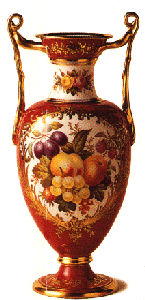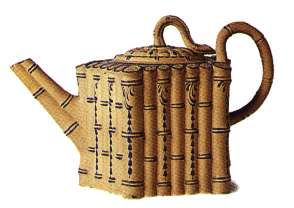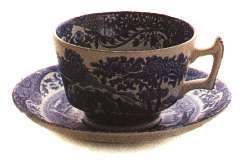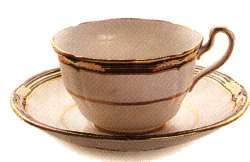![]()
Spode Ware
|
Spode Ware |
|
![]()

A superb example of ornamental Spode,
a handled vase entirely hand painted
by the artist, F. Adams from the late 18th century.
![]() Spode's products during the first quarter of the 19th century consisted mainly
of neatly potted useful wares with the elegantly simple shapes characteristic of
Regency style. Typically, they were decorated with topographical views, country
scenes, or flowers, by the bat-printing technique, a type of transfer-printing,
in which the design was transferred to the porcelain on a pad, or bat, of
gelatin, which produced a softly stippled effect. Alternatively, the wares were
painted with flowers in bunches or sprigs in a huge variety of patterns. Both
types of decoration were enhanced by gilded borders.
Spode's products during the first quarter of the 19th century consisted mainly
of neatly potted useful wares with the elegantly simple shapes characteristic of
Regency style. Typically, they were decorated with topographical views, country
scenes, or flowers, by the bat-printing technique, a type of transfer-printing,
in which the design was transferred to the porcelain on a pad, or bat, of
gelatin, which produced a softly stippled effect. Alternatively, the wares were
painted with flowers in bunches or sprigs in a huge variety of patterns. Both
types of decoration were enhanced by gilded borders.
![]() Under Spode's leading decorator, Henry Daniel, new gilding
and enamelling techniques, and effects such as lustre
decoration, were introduced, sometimes for lavishly decorated display
pieces. The earlier staples, earthenwares and stonewares, were continued, and a
range of interesting unglazed bodies—basalts,
redwares, and canewares—were among Spode's novelties.
Under Spode's leading decorator, Henry Daniel, new gilding
and enamelling techniques, and effects such as lustre
decoration, were introduced, sometimes for lavishly decorated display
pieces. The earlier staples, earthenwares and stonewares, were continued, and a
range of interesting unglazed bodies—basalts,
redwares, and canewares—were among Spode's novelties.
 |
One of the earliest Spode pieces in existence, an enamelled teapot, c.1780
An example of caneware. |
![]() A new form of stoneware, decorated in Oriental style with blue transfer prints
and polychrome painting, marketed as Spode's Stone China, was added from about
1813.
A new form of stoneware, decorated in Oriental style with blue transfer prints
and polychrome painting, marketed as Spode's Stone China, was added from about
1813.
![]() Spode remained at the
forefront of bone china and stone china production until 1833, when the factory
was acquired by William Taylor Copeland and Thomas Garrett: it remained under
their names until 1847, when Copeland became the sole owner.
Spode remained at the
forefront of bone china and stone china production until 1833, when the factory
was acquired by William Taylor Copeland and Thomas Garrett: it remained under
their names until 1847, when Copeland became the sole owner.
![]() During the 1840s a new hard, white unglazed porcelain, known as "statuary
porcelain" and later as "Parian" from
its marble-like quality, was first produced. It was acclaimed as the ideal
material for ornamental figures and sculptures, and it became one of the great
successes of Victorian ceramic art.
During the 1840s a new hard, white unglazed porcelain, known as "statuary
porcelain" and later as "Parian" from
its marble-like quality, was first produced. It was acclaimed as the ideal
material for ornamental figures and sculptures, and it became one of the great
successes of Victorian ceramic art.
![]() As well as producing Parian ware and elaborate dinner services for special
commissions, the factory maintained its output of high-quality decorated wares
with plenty of gilding. Some of the best were painted by Charles Ferdinand
Hürten, the leading flower painter of his day.
As well as producing Parian ware and elaborate dinner services for special
commissions, the factory maintained its output of high-quality decorated wares
with plenty of gilding. Some of the best were painted by Charles Ferdinand
Hürten, the leading flower painter of his day.
![]() Spode participated with great success in the international exhibitions of the
period. Most important was the wide range of well-made but practical (and
commercial) tablewares produced throughout the 19th century.
Spode participated with great success in the international exhibitions of the
period. Most important was the wide range of well-made but practical (and
commercial) tablewares produced throughout the 19th century.
|
Two
of the most important developments |
|
 Blue underglaze printing |
 Spode Fine Bone China |

Spode Crest
found on current ware
![]()
of Spode
![]()
questions / comments? email Steve Birks steveb@netcentral.co.uk